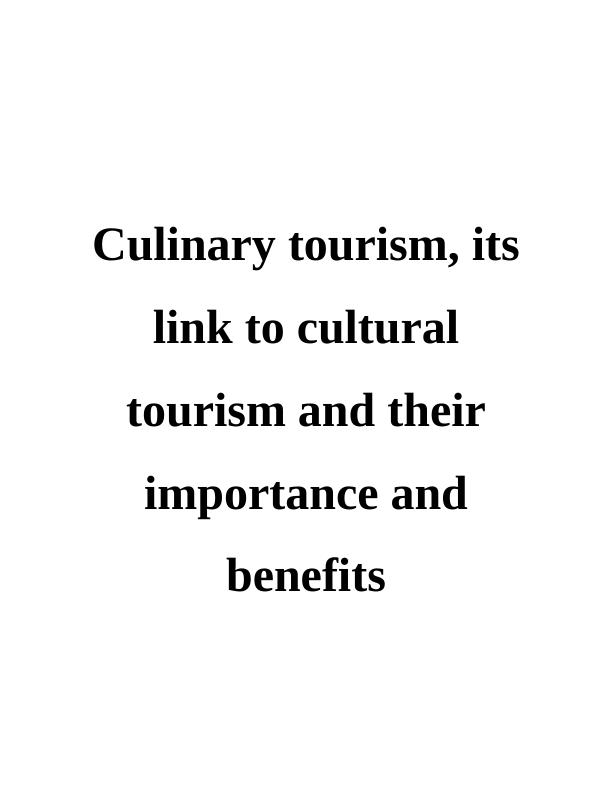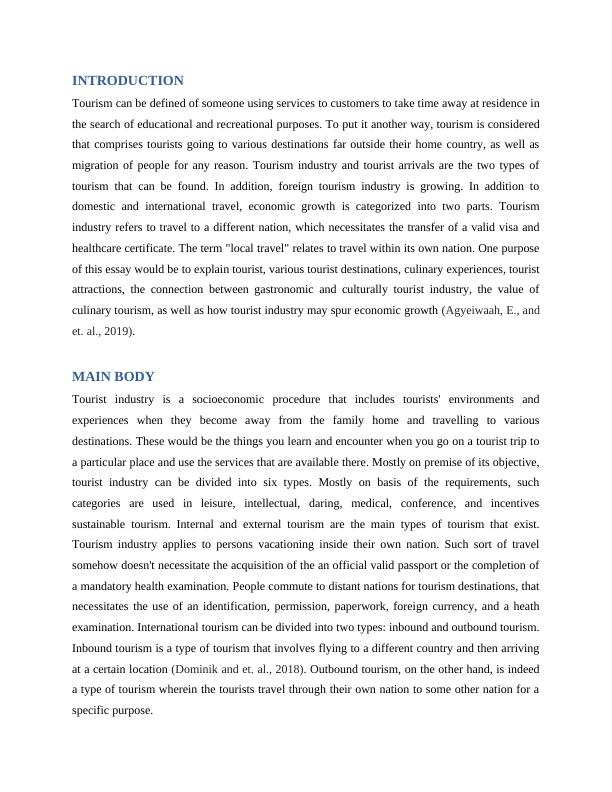Culinary Tourism: Link to Cultural Tourism and Its Importance and Benefits
Added on 2022-11-25
11 Pages3637 Words164 Views
Culinary tourism, its
link to cultural
tourism and their
importance and
benefits
link to cultural
tourism and their
importance and
benefits

Contents
INTRODUCTION...........................................................................................................................................3
MAIN BODY..................................................................................................................................................3
CONCLUSION.............................................................................................................................................10
INTRODUCTION...........................................................................................................................................3
MAIN BODY..................................................................................................................................................3
CONCLUSION.............................................................................................................................................10

INTRODUCTION
Tourism can be defined of someone using services to customers to take time away at residence in
the search of educational and recreational purposes. To put it another way, tourism is considered
that comprises tourists going to various destinations far outside their home country, as well as
migration of people for any reason. Tourism industry and tourist arrivals are the two types of
tourism that can be found. In addition, foreign tourism industry is growing. In addition to
domestic and international travel, economic growth is categorized into two parts. Tourism
industry refers to travel to a different nation, which necessitates the transfer of a valid visa and
healthcare certificate. The term "local travel" relates to travel within its own nation. One purpose
of this essay would be to explain tourist, various tourist destinations, culinary experiences, tourist
attractions, the connection between gastronomic and culturally tourist industry, the value of
culinary tourism, as well as how tourist industry may spur economic growth (Agyeiwaah, E., and
et. al., 2019).
MAIN BODY
Tourist industry is a socioeconomic procedure that includes tourists' environments and
experiences when they become away from the family home and travelling to various
destinations. These would be the things you learn and encounter when you go on a tourist trip to
a particular place and use the services that are available there. Mostly on premise of its objective,
tourist industry can be divided into six types. Mostly on basis of the requirements, such
categories are used in leisure, intellectual, daring, medical, conference, and incentives
sustainable tourism. Internal and external tourism are the main types of tourism that exist.
Tourism industry applies to persons vacationing inside their own nation. Such sort of travel
somehow doesn't necessitate the acquisition of the an official valid passport or the completion of
a mandatory health examination. People commute to distant nations for tourism destinations, that
necessitates the use of an identification, permission, paperwork, foreign currency, and a heath
examination. International tourism can be divided into two types: inbound and outbound tourism.
Inbound tourism is a type of tourism that involves flying to a different country and then arriving
at a certain location (Dominik and et. al., 2018). Outbound tourism, on the other hand, is indeed
a type of tourism wherein the tourists travel through their own nation to some other nation for a
specific purpose.
Tourism can be defined of someone using services to customers to take time away at residence in
the search of educational and recreational purposes. To put it another way, tourism is considered
that comprises tourists going to various destinations far outside their home country, as well as
migration of people for any reason. Tourism industry and tourist arrivals are the two types of
tourism that can be found. In addition, foreign tourism industry is growing. In addition to
domestic and international travel, economic growth is categorized into two parts. Tourism
industry refers to travel to a different nation, which necessitates the transfer of a valid visa and
healthcare certificate. The term "local travel" relates to travel within its own nation. One purpose
of this essay would be to explain tourist, various tourist destinations, culinary experiences, tourist
attractions, the connection between gastronomic and culturally tourist industry, the value of
culinary tourism, as well as how tourist industry may spur economic growth (Agyeiwaah, E., and
et. al., 2019).
MAIN BODY
Tourist industry is a socioeconomic procedure that includes tourists' environments and
experiences when they become away from the family home and travelling to various
destinations. These would be the things you learn and encounter when you go on a tourist trip to
a particular place and use the services that are available there. Mostly on premise of its objective,
tourist industry can be divided into six types. Mostly on basis of the requirements, such
categories are used in leisure, intellectual, daring, medical, conference, and incentives
sustainable tourism. Internal and external tourism are the main types of tourism that exist.
Tourism industry applies to persons vacationing inside their own nation. Such sort of travel
somehow doesn't necessitate the acquisition of the an official valid passport or the completion of
a mandatory health examination. People commute to distant nations for tourism destinations, that
necessitates the use of an identification, permission, paperwork, foreign currency, and a heath
examination. International tourism can be divided into two types: inbound and outbound tourism.
Inbound tourism is a type of tourism that involves flying to a different country and then arriving
at a certain location (Dominik and et. al., 2018). Outbound tourism, on the other hand, is indeed
a type of tourism wherein the tourists travel through their own nation to some other nation for a
specific purpose.

This travel industry has a significant impact on the economy since it contributes to provide
employment, income, and opportunities for numerous firms to grow locally and internationally.
That British Country's economy is heavily dependent on travel. Travel is rising at a faster rate
than that of the Uk market. This tourist economy has had a number of negative economic
consequences. Additional jobs have been created as a result of the experiences, resulting in
maximum revenue for the private and hotel businesses. Travel has raised government revenue,
infrastructure development, expanded the regional economy, and earned export earnings through
its operations. Culinary tourism, also related to food tourist activities, is a growing segment of
specialised tourist industry wherein the travellers come to specific regions to sample authentic
food and keep reminding oneself inside the reality of going well through eating. Beverages,
meats, candies, as well as other delights from the region are regularly featured. Culinary tourism
has been incredibly common amongst famous restaurants, champagne pastry chefs, and foodies
in recent years. As just a reaction, towns known for its excellent cuisine and drinks has started to
offer organised tours that take guests to the best restaurants and cafes (Fernando, E., and et. al.,
2019).
Such vacations might include some transportation as well as other financial advantages. It
convey visiting organisations to locations that they may not be aware of. Joining a gastronomic
trip is therefore one excellent choice for those that want to dodge tourist hotspots while still
enjoying a genuine insight into local cuisine. Moreover, gastronomic tourists gather together
those people who will all be there for whatever purpose: that acquire a good taste of the place.
Some eaters combine tourist experience and traditional cuisine courses to further their
enthusiasm for culinary, willingness to take significant ingredients and preparing food techniques
along alongside themselves. Food critics who specialise in ethnic food may give them access
with well culinary courses, hotels for the in visitors, and personal trainers who specialise within
regional cuisine (Hajarrahmah, D. and Daniels-Llanos, M., 2017).
Culinary development has the potential to help restore cultural customs even while implementing
digital and utilising current tourist destinations. Through increasing visitor demand for local
drinks and snacks, tourism industry contributes to the long-term sustainability of sustainable
practices, agricultural practises, industries, and traditions. Culinary tourism may also encourage
“impersonal” portrayals of culinary traditions by emphasising on more odd, unique, and
employment, income, and opportunities for numerous firms to grow locally and internationally.
That British Country's economy is heavily dependent on travel. Travel is rising at a faster rate
than that of the Uk market. This tourist economy has had a number of negative economic
consequences. Additional jobs have been created as a result of the experiences, resulting in
maximum revenue for the private and hotel businesses. Travel has raised government revenue,
infrastructure development, expanded the regional economy, and earned export earnings through
its operations. Culinary tourism, also related to food tourist activities, is a growing segment of
specialised tourist industry wherein the travellers come to specific regions to sample authentic
food and keep reminding oneself inside the reality of going well through eating. Beverages,
meats, candies, as well as other delights from the region are regularly featured. Culinary tourism
has been incredibly common amongst famous restaurants, champagne pastry chefs, and foodies
in recent years. As just a reaction, towns known for its excellent cuisine and drinks has started to
offer organised tours that take guests to the best restaurants and cafes (Fernando, E., and et. al.,
2019).
Such vacations might include some transportation as well as other financial advantages. It
convey visiting organisations to locations that they may not be aware of. Joining a gastronomic
trip is therefore one excellent choice for those that want to dodge tourist hotspots while still
enjoying a genuine insight into local cuisine. Moreover, gastronomic tourists gather together
those people who will all be there for whatever purpose: that acquire a good taste of the place.
Some eaters combine tourist experience and traditional cuisine courses to further their
enthusiasm for culinary, willingness to take significant ingredients and preparing food techniques
along alongside themselves. Food critics who specialise in ethnic food may give them access
with well culinary courses, hotels for the in visitors, and personal trainers who specialise within
regional cuisine (Hajarrahmah, D. and Daniels-Llanos, M., 2017).
Culinary development has the potential to help restore cultural customs even while implementing
digital and utilising current tourist destinations. Through increasing visitor demand for local
drinks and snacks, tourism industry contributes to the long-term sustainability of sustainable
practices, agricultural practises, industries, and traditions. Culinary tourism may also encourage
“impersonal” portrayals of culinary traditions by emphasising on more odd, unique, and

End of preview
Want to access all the pages? Upload your documents or become a member.
Related Documents
Culinary Tourism: Link to Cultural Tourism and its Importance and Benefitslg...
|11
|3544
|110
Culinary Tourism and Cultural Tourism: Importance and Benefitslg...
|11
|3992
|369
Contemporary Issues in Travel and Tourism - Task 2lg...
|13
|960
|69
Tourism – Operations Managementlg...
|11
|3099
|451
( P33 ) Contemporary Issues in Travel and Tourismlg...
|8
|407
|257
Effects of Current and Recent Trends in Tour Operations Managementlg...
|2
|888
|35
